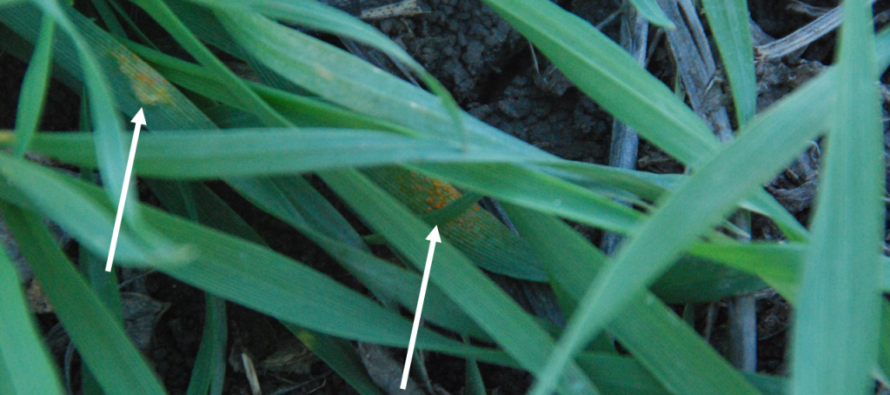Scouting and Managing Wheat Stripe Rust Infection at Tillering Stages


General yellow wheat field appearance that follows standing water or extended periods of cold weather. Fields with this general appearance should be carefully scouted since the yellow plants can be confused with disease symptoms.
Over the past several weeks, hot spots of stripe rust have been observed in Louisiana, Arkansas, and as of yesterday one isolated field in Mississippi. Early observations of stripe rust, generally when wheat is in the tillering stages, can occur following a fall infection. Stripe rust on wheat at tillering stages will generally not form the “striping” pattern and will be more of a mass of pustules producing sporulation on leaves. While scouting the wheat variety trial plot yesterday (2/11/2015) in Stoneville, MS I was able to easily identify stripe rust in several plots with heavy sporulation. When observing wheat fields for the presence of stripe rust do not just focus on areas of fields with yellow plants. Keep in mind that many of the wheat fields throughout MS have a yellow hue to them due to the wet winter we’ve had to this point and overall poor nutrient uptake. As wheat fields dry out and the sun allows the plant to grow more “normally” the yellow hue in fields will likely dissipate. When scouting for stripe rust do not think that all yellow fields contain stripe rust or another disease, such as Barley yellow dwarf virus. For scouting purposes, the stripe rust that has been observed in AR and MS has been observed from the standing position. So at least you won’t need to be on hands and knees to observe the disease. But, with that in mind, there are times where infected leaves will be obscured by some of the aboveground foliage. Close inspection of wheat fields should be done. Scout for the presence of clumps of plants that may be infected with the fungus. Following the warm temperatures we have experienced over the past several weeks, stripe rust has had an extremely conducive environment to reproduce and infect additional wheat plants.

Stripe rust will appear on infected wheat plants in more of a clump than have the more traditional “stripe” pattern.
Management options
Wheat plants, regardless of their overall response to the stripe rust fungus (resistant or susceptible), do not develop resistance to the stripe rust fungus until they reach “adult” stages. Therefore, all wheat varieties at the tillering growth stages are susceptible to the fungus. However, it is not known at what specific growth stage the adult plant resistance is expressed. For more information regarding specific wheat growth stages see: http://www.mississippi-crops.com/2014/03/20/identifying-wheat-growth-stages-using-the-feekes-scale/. Based on research conducted at other universities, stripe rust infection at the tillering stages can negatively affect yield performance. Fungicide application, even during tillering stages can reduce the overall potential yield loss as a result of winter stripe rust infection (if the disease is present in a field). Triazole products will provide a benefit in fields where infection centers (hot spots) are identified. However, keep in mind that many of the products that can be applied to wheat have strict label restrictions with regards to the number of applications and total fl oz/A that can be applied in a single season (e.g., propiconazole (8 fl oz/A total/season), tebuconazole (4 fl oz/a total/season)). For more information regarding the specific products that contain tebuconazole as well as the label restriction visit: https://www.mississippi-crops.com/2013/04/02/important-notice-tebuconazole-label-restrictions-in-wheat/. Product selection and application should be based on the presence of stripe rust in a wheat field, overall yield potential of the field, and product availability. Keep in mind that numerous generic products that contain triazole active ingredients are likely available and can help save a tremendous amount of application cost. Also be mindful, a fungicide application does not “make” the wheat crop. Do not skip some of the more important management practices when growing your wheat crop and expect the fungicide to “rescue” the crop at the end of the day.

Stripe rust at the tillering growth stage can be obscured more deeply in the canopy by developing foliage.
For more information on the developing situation in Arkansas refer to: http://www.arkansas-crops.com/2015/02/11/wheat-stripe-update/.



